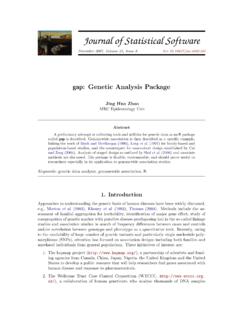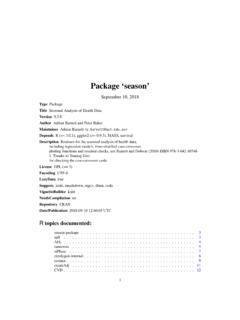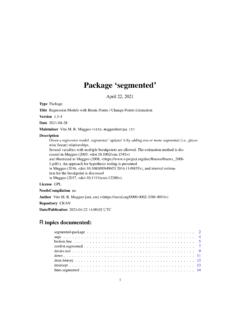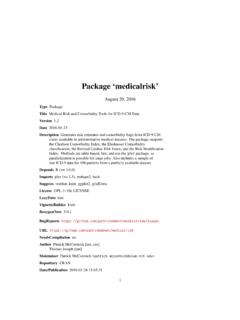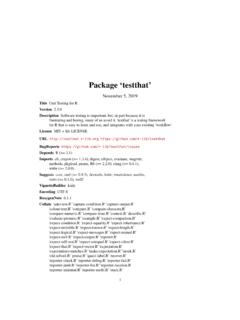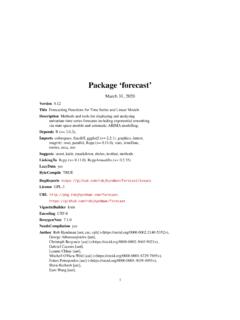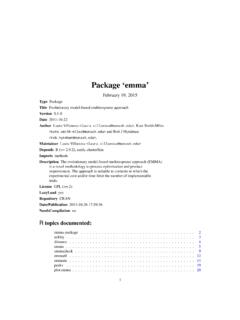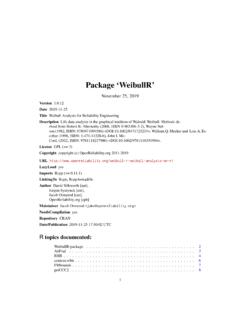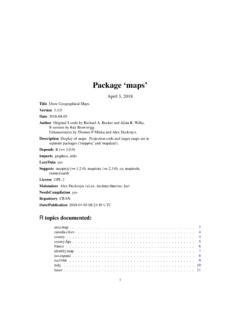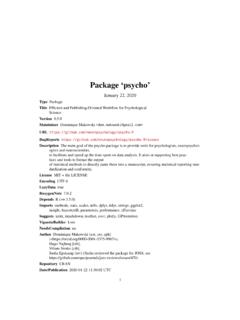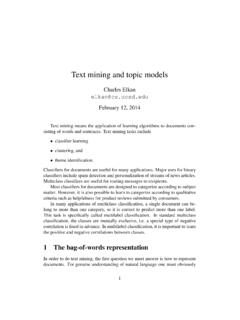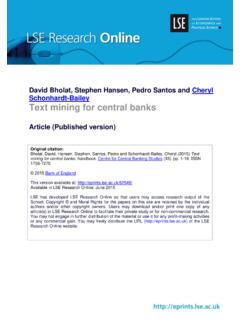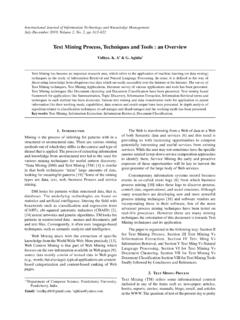Transcription of Introduction to the tm Package Text Mining in R
1 Introduction to thetmPackageText Mining inRIngo FeinererDecember 21, 2018 IntroductionThis vignette gives a short Introduction to text Mining inRutilizing the text Mining framework provided bythetmpackage. We present methods for data import, corpus handling, preprocessing, metadata management,and creation of term-document matrices. Our focus is on the main aspects of getting started with text mininginR an in-depth description of the text Mining infrastructure offered bytmwas published in theJournal ofStatistical Software(Feinerer et al., 2008). An introductory article on text Mining inRwas published inRNews(Feinerer, 2008).Data ImportThe main structure for managing documents intmis a so-calledCorpus, representing a collection of textdocuments.
2 A corpus is an abstract concept, and there can exist several implementations in parallel. Thedefault implementation is the so-calledVCorpus(short forVolatile Corpus) which realizes a semantics as knownfrom mostRobjects: corpora areRobjects held fully in memory. We denote this as volatile since once theRobject is destroyed, the whole corpus is gone. Such a volatile corpus can be created via the constructorVCorpus(x, readerControl). Another implementation is thePCorpuswhich implements aPermanent Corpussemantics, , the documents are physically stored outside ofR( , in a database), correspondingRobjectsare basically only pointers to external structures, and changes to the underlying corpus are reflected to allRobjects associated with it.
3 Compared to the volatile corpus the corpus encapsulated by a permanent corpusobject is not destroyed if the correspondingRobject is the corpus constructor,xmust be aSourceobject which abstracts the input aset of predefined sources, ,DirSource,VectorSource, orDataframeSource, which handle a directory, a vectorinterpreting each component as document, or data frame like structures (likeCSVfiles), respectively. ExceptDirSource, which is designed solely for directories on a file system, andVectorSource, which only accepts (char-acter) vectors, most other implemented sources can take connections as input (a character string is interpretedas file path).getSources()lists available sources, and users can create their own second argumentreaderControlof the corpus constructor has to be a list with the named componentsreaderandlanguage.
4 The first componentreaderconstructs a text document from elements delivered bya source. Thetmpackage ships with several readers ( ,readPlain(),readPDF(),readDOC(), .. ). SeegetReaders()for an up-to-date list of available readers. Each source has a default reader which can beoverridden. , forDirSourcethe default just reads in the input files and interprets their content as , the second componentlanguagesets the texts language (preferably usingISO639-2 codes).In case of a permanent corpus, a third argumentdbControlhas to be a list with the named componentsdbNamegiving the filename holding the sourced out objects ( , the database), anddbTypeholding a validdatabase type as supported by packagefilehash.
5 Activated database support reduces the memory demand,however, access gets slower since each operation is limited by the hard disk s read and write , plain text files in the directorytxtcontaining Latin (lat) texts by the Roman poetOvidcan beread in with following code:> txt <- (" texts ", "txt", Package = "tm")> (ovid <- VCorpus(DirSource(txt, encoding = "UTF-8"),+ readerControl = list(language = "lat")))<<VCorpus>>Metadata: corpus specific: 0, document level (indexed): 0 Content: documents: 51 For simple examplesVectorSourceis quite useful, as it can create a corpus from character vectors, :> docs <- c("This is a text.", "This another one.")> VCorpus(VectorSource(docs))<<VCorpus>>Metadata: corpus specific: 0, document level (indexed): 0 Content: documents: 2 Finally we create a corpus for some Reuters documents as example for later use.
6 > reut21578 <- (" texts ", "crude", Package = "tm")> reuters <- VCorpus(DirSource(reut21578, mode = "binary"),+ readerControl = list(reader = readReut21578 XMLasPlain))Data ExportFor the case you have created a corpus via manipulating other objects inR, thus do not have the texts alreadystored on a hard disk, and want to save the text documents to disk, you can simply usewriteCorpus()> writeCorpus(ovid)which writes a character representation of the documents in a corpus to multiple files on CorporaCustomprint()methods are available which hide the raw amount of information (consider a corpus couldconsist of several thousand documents, like a database).print()gives a concise overview whereas more detailsare displayed withinspect().
7 > inspect(ovid[1:2])<<VCorpus>>Metadata: corpus specific: 0, document level (indexed): 0 Content: documents: 2[[1]]<<PlainTextDocument>>Metadata: 7 Content: chars: 676[[2]]<<PlainTextDocument>>Metadata: 7 Content: chars: 700 Individual documents can be accessed via[[, either via the position in the corpus, or via their identifier.> meta(ovid[[2]], "id")[1] " "> identical(ovid[[2]], ovid[[" "]])[1] TRUEA character representation of a document is available ()which is also used when inspectinga document:> inspect(ovid[[2]])2<<PlainTextDocument>>Metadata: 7 Content: chars: 700quas Hector sensurus erat, poscente magistroverberibus iussas praebuit ille Chiron, ego sum praeceptor Amoris:saevus uterque puer, natus uterque tamen et tauri cervix oneratur aratro,frenaque magnanimi dente teruntur equi.]]
8 Et mihi cedet Amor, quamvis mea vulneret arcupectora, iactatas excutiatque me fixit Amor, quo me violentius ussit,hoc melior facti vulneris ultor ero:non ego, Phoebe, datas a te mihi mentiar artes,nec nos a eriae voce monemur avis,nec mihi sunt visae Clio Cliusque sororesservanti pecudes vallibus, Ascra, tuis:usus opus movet hoc: vati parete perito;> lapply(ovid[1:2], )$ [1] " Si quis in hoc artem populo non novit amandi,"[2] " hoc legat et lecto carmine doctus amet."[3] " arte citae veloque rates remoque moventur,"[4] " arte leves currus: arte regendus amor."[5] ""[6] " curribus Automedon lentisque erat aptus habenis,"[7] " Tiphys in Haemonia puppe magister erat:"[8] " me Venus artificem tenero praefecit Amori;"[9] " Tiphys et Automedon dicar Amoris ego.
9 "[10] " ille quidem ferus est et qui mihi saepe repugnet:"[11] ""[12] " sed puer est, aetas mollis et apta regi."[13] " Phillyrides puerum cithara perfecit Achillem,"[14] " atque animos placida contudit arte feros."[15] " qui totiens socios, totiens exterruit hostes,"[16] " creditur annosum pertimuisse senem."$ [1] " quas Hector sensurus erat, poscente magistro"[2] " verberibus iussas praebuit ille manus."[3] " Aeacidae Chiron, ego sum praeceptor Amoris:"[4] " saevus uterque puer, natus uterque dea."[5] " sed tamen et tauri cervix oneratur aratro,"[6] ""[7] " frenaque magnanimi dente teruntur equi;"[8] " et mihi cedet Amor, quamvis mea vulneret arcu"[9] " pectora, iactatas excutiatque faces.
10 "[10] " quo me fixit Amor, quo me violentius ussit,"[11] " hoc melior facti vulneris ultor ero:"[12] ""[13] " non ego, Phoebe, datas a te mihi mentiar artes,"[14] " nec nos a eriae voce monemur avis,"[15] " nec mihi sunt visae Clio Cliusque sorores"[16] " servanti pecudes vallibus, Ascra, tuis:"[17] " usus opus movet hoc: vati parete perito;"3 TransformationsOnce we have a corpus we typically want to modify the documents in it, , stemming, stopword removal,et cetera. Intm, all this functionality is subsumed into the concept of atransformation. Transformations aredone via thetm_map()function which applies (maps) a function to all elements of the corpus.
